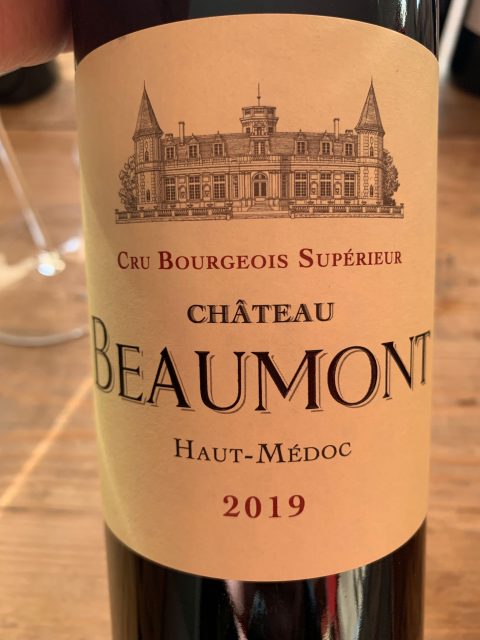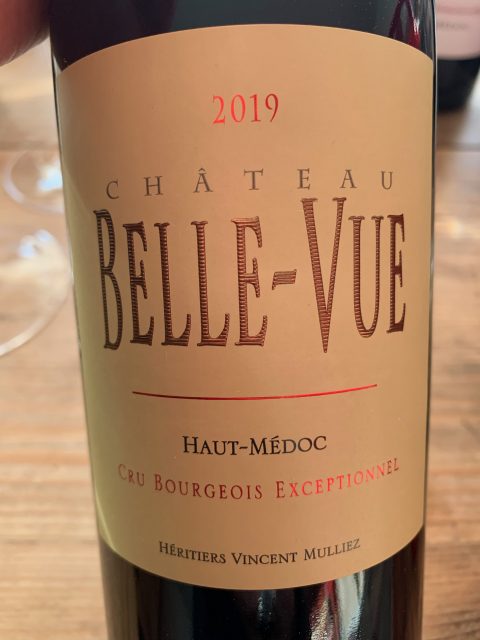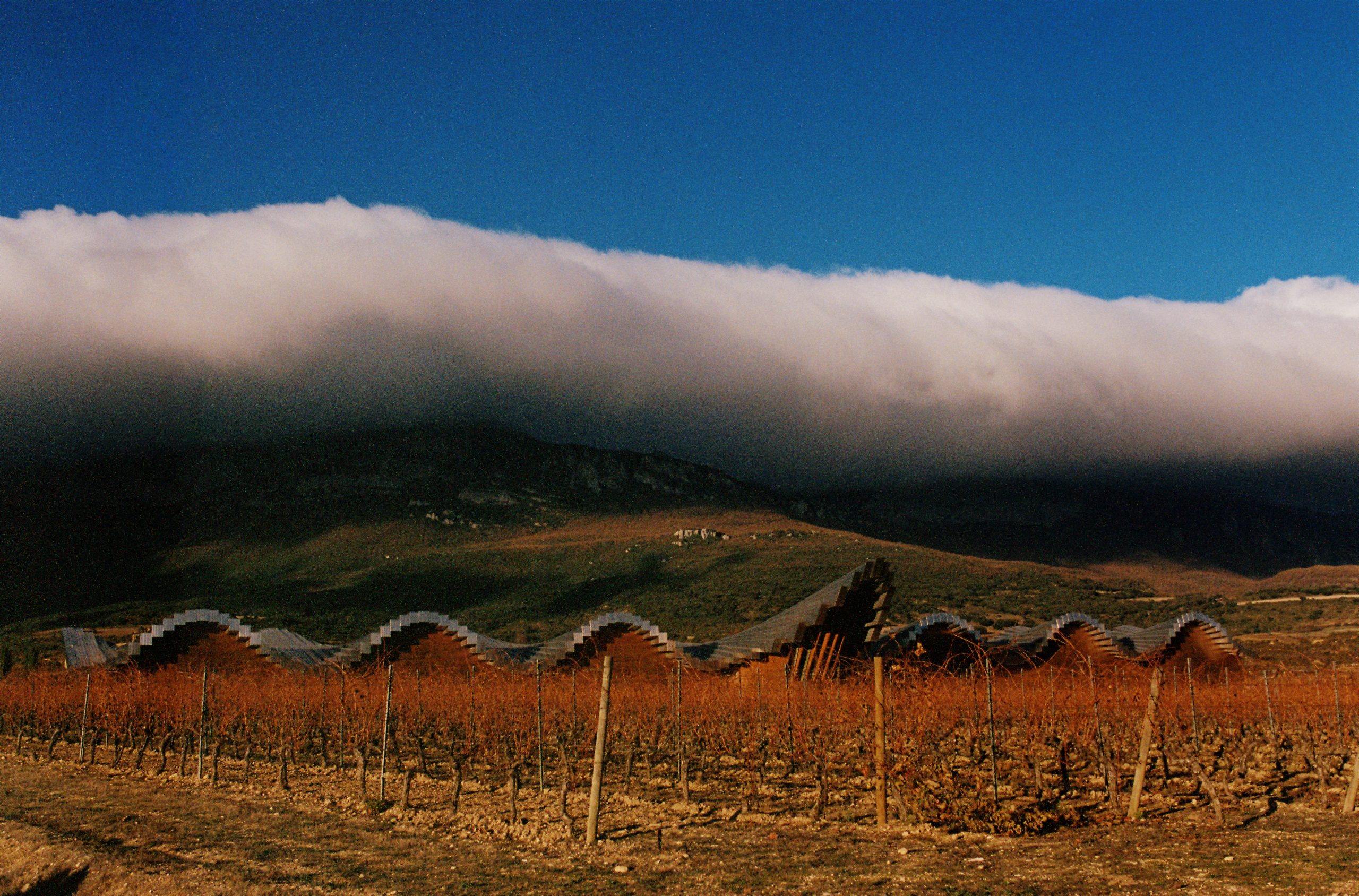The cru bourgeois de Médoc 2019: the verdict
Our Bordeaux correspondent Colin Hay casts his judgement on the 2019 vintage of the cru bourgeois de Médoc, as he charts the renaissance and rebirth of the classification system.

|
*Samples supplied by l’Alliance des Crus Bourgeois which was invited to provide a representative sub-set of the wines of the classification, including wines at each quality level and each from appellation. All wines tasted in Paris from Zalto and Grassl stemware in January 2022.
Chateau Beaumont 2019 (Haut-Médoc, cru bourgeois supérieur; a vineyard of around 100 hectares on sand and gravel in Cussac-Fort-Médoc owned by Grands Millésimes de France, who also own Château Beychevelle and the Bordeaux negociant Barrière Frères; 53% Cabernet Sauvignon; 45% Merlot; 2% Petit Verdot; 13.5% alcohol). The most aromatic of all of these wines – very much in the style of Beychevelle (its sister GMF property) itself (as it has so often been in recent vintage). Lots of evident stony minerality, baked earth, cedar and linseed and a dark stone fruit; quite spicy too – cinnamon, cardamom, red peppercorns and nutmeg. Very soft and refined with a nice pick-up as the tannins start to grip and bring architecture to the mid-palate before a long and tapering finish. Very impressive and approachable already. What I like about this perhaps most of all is that you might well pick it in a blind tasting – and if you did, it would be through the association with Beychevelle (the quality of the tannins, the glorious texture and the seductive cedar elements that build as the wine inhales). 90.

Chateau Belle-Vue 2019 (Haut-Médoc, cru bourgeois exceptionnel; a vineyard of around 15 hectares in the commune of Macau next to Chateau Giscours, right on the appellation border with Margaux; 48% Cabernet Sauvignon; 30% Merlot; 20% Petit Verdot; 1% Carmenere; 1% Cabernet Franc; 14% alcohol). One of the most reliable wines of the appellation, this always represents excellent value. This takes a moment to come together in the glass, revealing as it does so quite a feral and ferrous minerality. But then comes the fruit, which is bright and confident – plump, ripe red berries and darker stone fruit notes too, accompanied by cracked black peppercorns and fennel seeds. On the palate, like de Malleret, this has a wonderfully intense fresh and bright juicy sapidity. Lots of energy and tension if, at this stage, more complexity on the palate than the nose (though, with more air, one starts to detect the floral notes that will develop further with age). Give this a couple of years in the cellar and it will be very fine indeed – the density and concentration in the mid-palate is particularly impressive and hints at the quality of the terroir. 91.
Chateau de Malleret 2019 (Haut-Médoc, cru bourgeois exceptionnel; a vineyard of around 47 hectares on an excellent terroir of Guntzian gravel in Le Pian-Médoc; 54% Cabernet Sauvignon; 44% Merlot; 2% Petit Verdot; 14% alcohol; Stéphane Derenoncourt is the consultant). Bright, lively and incredibly racy and refreshing already on the nose. Deep, dark stone fruit – plums, sloes and damsons – and wild thyme too. This has a fabulous juicy sapidity all the way from the attack to the finish. Refined, elegant with lots of finesse but also lots of personality. This needs a couple more years in bottle for the tannins on the finish to soften just a touch more, but there is great potential here. 90+.
Chateau Cap Léon Veyrin 2019 (Listrac-Médoc; cru bourgeois supérieur; from a vineyard of 17 hectares on clay and limestone; 50% Merlot; 45% Cabernet Sauvignon; 5% Petit Verdot; aged in oak barrels, around 60% of which are new; 14% alcohol). Glossy, limpid, slightly inky in complexion with a radiant crimson/pink rim, this is very impressive. A lovely bright and engaging earthy, herb-tinged, dark berry fruit – crushed brambles and blackberries – and a verticality and lift on the nose that I suspect comes from the limestone in the terroir. This has incredibly finely-grained and well-managed tannins for a wine at this price point, allowing the focus of attention even at this very youthful stage to be on the purity and precision of the delicate yet fresh and bright fruit. Gentle and seductive, yet serene and composed at the same time. Lovely. 91.
Chateau Lestage 2019 (Listrac-Médoc; cru bourgeois exceptionnel; from a vineyard of 35 hectares on clay and clay and limestone; 64% Merlot; 31% Cabernet Sauvignon; 3% Cabernet Franc; 2% Petit Verdot; aged in oak barrels, a quarter of which are renewed each year; 14.5% alcohol). Dark hued, but impressively translucent in the glass – showing the gentle and judicious extraction here. The nose is gorgeous, with very classical pencil-shaving, cedar and acacia accompanying the deep, plump, earthy dark berry fruit; there’s a little hint of verbena too. This is just what you want from a top cru bourgeois – which is exactly what this is. For the price I really cannot recommend this strongly enough. Sinuous and with ultra-fine grained tannins that build as they structure the mid-palate, there is something very elegant but also slightly austere and imposing about this wine that elevates it above most of its peers. Excellent wine-making, lots of personality, long and juicy on the finish and highly recommended. 91+.
Chateau d’Arsac 2019 (Margaux; cru bourgeois exceptionnel; 72% Cabernet Sauvignon; 28% Merlot; from a vineyard of 54 hectares on a famous black sand and sandy-gravel terroir with smaller pockets of clay; 13.5% alcohol). Bright, radiant and limpid in the glass, this is quite viscous and its appearance already indicates a delicate and gentle extraction. Soft and quite voluptuous on the nose, this is very Margellais – with lovely, deep dark berry fruit (cassis and black raspberries) and an intense and very natural florality. On the palate this is ultra-soft with cashmere tannins and that lovely diaphanous and sinuous quality of the vintage. This is a wine that I have followed over many vintages and so it is no surprise that it is so good – nor that it has been judged of cru bourgeois exceptionnel status. An excellent ambassador for its appellation and the classification. 92.
Chateau Deyrem Valentin 2019 (Margaux; cru bourgeois supérieur; 56% Cabernet Sauvignon; 43% Merlot; 1% Petit Verdot; from a vineyard of 13 hectares on a Garonne gravel terroir; aged in oak barrels, half of which are new each vintage; 14% alcohol). One of the darkest in colour of these wines, but also less extracted and less full in colour than many. On the nose, this is at first just a little green and very dominated by the Cabernet fruit – cassis and blackberry, with a touch of fresh mint, green pepper and crushed black pepper. As it builds in the glass, the more classically floral notes of the appellation start to appear – wild herbs and hedgerow flowers. On the palate, this is another subtle and delicate wine with soft and gentle tannins – at least at first. The wine, slender at first, fans out quite a bit towards the end, but as it does do so, the tannins become just a touch harsh and ever so slightly green. That said, I love the sinuous and open-textured mid-palate. 90.
Partner Content
Chateau Castera 2019 (Médoc, cru bourgeois supérieur; an ancient and massive estate of 185 hectares, though only 63 are under vine; they are planted 66% Merlot; 26% Cabernet Sauvignon; 6% Cabernet Franc; 2% Petit Verdot; 13% alcohol; Eric Boissenot is the consultant). A shade or two darker in the glass than Vieux Robin, with more evident limpidity too. This is classically Médocain and is already revealing that lovely essence of cedar that one craves – all the more so in fact when one doesn’t find it or when one finds it unexpectedly! Here it is more like re-encountering an old friend. Deep, quite rich and dynamic and with an impressive sense of balance and harmony. The tannins are super-fine grained and, again, one has the clarity and luminous quality of the vintage that one finds with the classed growths. Tender and sapid through the mid-palate. Very impressive and with decent length, even if the finish is a little etiolated. 90.
Chateau La Cardonne 2019 (Médoc, cru bourgeois supérieur; around 51 hectares; 49% Cabernet Sauvignon; 49% Merlot; 2% Petit Verdot; 13.5% alcohol). This takes a little while to compose itself and reveal its identity. But when it does it is quite distinctive. It is rich and gamey on the nose with a rather funky, feral note – lots of saline minerality and almost a slight hint of wet Labrador. The tannins are refined and svelte on the attack and this allow the wine to fan out quite impressively once the tannins start to grip. The red and dark berry and stone fruit is fresh and bright and there is plenty of energy here, though perhaps not quite the finesse or complexity at this stage of Castera, tasted alongside. 89.
Chateau Vieux Robin 2019 (Médoc, cru bourgeois; around 10 hectares next to Tour du By in Begadan; 50% Cabernet Sauvignon; 45% Merlot; 3% Petit Verdot; 2% Cabernet Franc; 14% alcohol). At this stage, rather reticent on the nose, but as it starts to open we find first delicate, ripe and plump raspberry notes, alongside spring hedgerow flowers and a hint of rain on an baked-earth path. On the palate this is quite gentle and delicate, with initially very soft tannins which turn just a little dry and slightly raspy towards the finish. Simple, but fresh and lithe; attractive, accessible early drinking. 86.
Chateau La Mouline 2019 (Moulis-en-Médoc, cru bourgeois supérieur; around 20 hectares on clay-limestone and gravel – around half of each; 13% alcohol). Not a wine I believe I have ever met before, but this is a lovely first encounter. Light, glossy and limpid in the glass and with a warm and radiant nose of wood smoke and black tea alongside a lively, fresh bright red berry and cherry fruit. This is floral too and with a little more air a little waft of cedar enters the frame (one picks it up again on the palate). Delicate, tender and with that lovely luminescence of the vintage. This has been judiciously extracted. On the evidence of this wine, extremely worthy of its cru bourgeois supérieur designation. One to look out for. Not a very powerful wine, but with a lovely natural balance and harmony. Very fine indeed. 90.
Chateau Myon de l’Enclos 2019 (Moulis-en-Médoc, cru bourgeois; 50% Merlot; 50% Cabernet Sauvignon; from around 5 hectares on clay, limestone and gravel, this is a smaller sibling property of Mayne Lalande in Listrac; 12.5% alcohol). Light, bright and accessible, this is nicely made and well-balanced. It lacks the complexity of La Mouline on the nose (and, I suspect, Mayne Lalande itself) and the palate is just a little sweeter, but there is plenty of charm, freshness and vitality – the characteristics of the vintage are well captured. Sapid and energetic, this is an easy and accessible wine to be enjoyed in its youth. 87.
Chateau Plantey 2019 (Pauillac; cru bourgeois; from a vineyard of 27 hectares on a gravel terroir; 50% Cabernet Sauvignon; 50% Merlot; aged in oak barrels, around a quarter of which are new). The sole representative of the appellation in the classification. On the nose this is quite earthy and herbal, almost a touch green, but certainly bright and fresh, with a red berry and darker stone fruit profile and a touch of almond skin. With a little more air we find a hint of cedar though this is then overwhelmed a little by the stony, ferrous minerality. Lithe and dynamic on the palate with an impressively diaphanous quality that is characteristic of the appellation in this very attractive vintage. Pushing cru bourgeois supérieur level, on the evidence of this vintage. 88+.
Chateau Le Boscq 2019 (St-Estéphe; cru bourgeois exceptionnel; from a vineayrd of 18 hectares of gravel hillocks on a clay subsoil; 46% Cabernet Sauvignon; 46% Merlot; 6% Petit Verdot; 2% Cabernet Franc; aged in oak barrels, 37% of which are new in this vintage; 13.5% alcohol). This is the darkest in hue and colour density, too, of the samples I received. On the nose it is big, bold, plump, aromatically very open and expressive at first, but then it recoils and turns inward just a little. The fruit is very pure and aerial – cassis and blackberry predominantly, with lovely graphite notes and a very pretty and quite subtle minerality – more crushed stones than the almost rusty and ferrous notes one often associates with St-Estéphe. The texture is sumptuous, with finely-grained and highly refined if still quite significant tannins. This is one of the broadest-shouldered and most structured wines of the set, but there is plenty of flesh to cover the bones here. It needs a little time, but the potential is evident. Classy, eloquent and well deserving of its cru bourgeois exceptionnel status. 92.
Chateau Le Crock 2019 (St-Estèphe; cru bourgeois exceptionnel; from a vineyard of 32 hectates on a terroir of Garonne gravel over a sandy-clay subsoil; 46% Cabernet Sauvignon; 43% Merlot; 7% Cabernet Franc; 4% Petit Verdot; aged in oak barrels, 30% of which are new; 14% alcohol). Owned by the Cuvelier family of the St-Julien second growth Chateau Léoville-Poyferré since 1903 and very well situated just behind Chateau Cos d’Estournel itself, this is always an exciting wine and it is good (if hardly surprising) to see its quality affirmed in the cru bourgeois classification. In 2019 it really shines. Tasted en primeur I recall reflecting that if one ever wanted to imagine what high quality St-Estèphe terroir would taste like if vinified by Léoville-Poyferré, this was the best way to find out. Now that the wine is in bottle, that is even more clearly the case. This has been improving with each successive vintage for a number of years and this is the best I’ve yet tasted. A wine that deserves much more recognition than it gets. This is made very much in the style of Leoville Poyferre, with Sara Lecompte Cuvelier is bringing something distinctive and original to this excellent St Estephe terroir. Garnet, with deep purple highlights. This has a very pure deep, almost slightly sombre, fresh dark fruity nose – blackberries, blueberries and brambles, with the oak now almost entirely absorbed. It leaves just the fainted waft of smoke and a gentle, subtle, spiciness. Soft on the entry yet crisp, fresh and energetic. The sappy tannins release little ripples of juiciness on the palate, accentuating the sense of structure. Very accomplished, with great integrity and depth. Very elegant. 93.
Chateau Petit Bocq 2019 (St-Estèphe; cru bourgeois supérieur; from a vineyard of 19.4 hectares, on a terroir that is primarily gravel with a little bit of limestone; 52% Cabernet Sauvignon; 46% Merlot; 2% Petit Verdot – I think, as the figures I were given sum to more than 100%; aged in French oak barrels, 50% of which are new each vintage; 14.5% alcohol). Another very impressive showing from a St-Estèphe vineyard in this excellent vintage. Plump and crunchy ripe dark berry fruit, cedar and graphite and an earthy, slightly saline minerality come together beautifully on the nose, with a northern Medocain hint of iodine from the Atlantic ocean spray not so very far away. Lithe and dynamic in and through the mid-palate, this is not quite as intense of compact as, say Le Crock, but it’s a very lovely expression of its terroir and of the vintage with a lovely aerial finish. 91
Read more:
The cru bourgeoisie: A classification reborn?
Related news
Bordeaux 2024 en primeur: St-Estèphe confounds expectations




